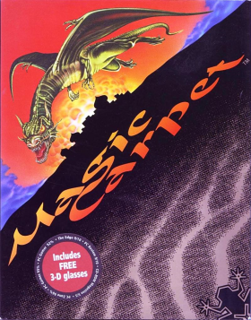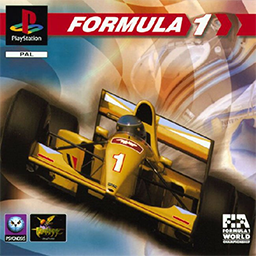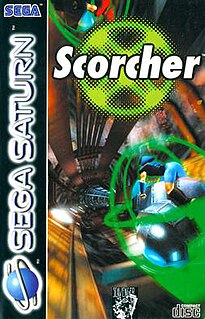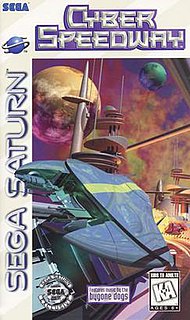
Theme Park is a construction and management simulation video game developed by Bullfrog Productions and published by Electronic Arts in 1994. The player designs and operates an amusement park, with the goal of making money and creating theme parks worldwide. The game is the first instalment in Bullfrog's Theme series and their Designer Series.

SEGA Rally Championship is a 1994 racing video game developed by Sega AM3 and published by Sega. Originally released for arcades using the Sega Model 2 board, it was converted to the Sega Saturn in 1995 and Windows in 1997. The unique selling point of Sega Rally Championship was the ability to drive on different surfaces, with different friction properties, with the car's handling changing accordingly. As the first racing game to incorporate this feature, Sega Rally Championship is considered to be one of the milestones in the evolution of the racing game genre. It was also an early rally racing game and featured cooperative gameplay alongside the usual competitive multiplayer.

Daytona USA is an arcade racing video game developed by Sega AM2 in 1993 and released by Sega in 1994. Players race stock cars on one of three courses. The first game released on the Sega Model 2 three-dimensional arcade system board, a prototype debuted at Tokyo's Amusement Machine Show in August 1993 and was location tested in Japan the same month, before the complete game released in March 1994. Daytona USA is one of the highest-grossing arcade games of all time.

Wipeout 2097 is a futuristic racing game developed and published by Psygnosis. It is the second installment released in the Wipeout series and the direct sequel of the original game released the previous year. It was originally released in 1996 for the PlayStation, and in 1997 for Microsoft Windows and the Sega Saturn. It was later ported by Digital Images to the Amiga in 1999 and by Coderus to Mac OS in 2002.

Magic Carpet is a 3D flying video game developed by Bullfrog Productions and published by Electronic Arts in 1994. Its graphics and gameplay were considered innovative and technically impressive at the time of its release.

Destruction Derby is a vehicular combat racing video game developed by Reflections Interactive and published by Psygnosis. Based on the sport of demolition derby, the game tasks the player with racing and destroying cars to score points. The developers implemented simulated physics to make the results of collisions easier to predict, and they kept the game's tracks small to increase the number of wrecks. Versions of Destruction Derby were released for MS-DOS, PlayStation and Sega Saturn. A Nintendo 64 version, Destruction Derby 64, was released in 1999 by Looking Glass Studios and THQ. Critics found Destruction Derby enjoyable and they praised its graphics and car damage system, but the Nintendo 64 and Sega Saturn releases received mixed reviews. The game started the Destruction Derby franchise, beginning with its 1996 sequel, Destruction Derby 2.
Gungriffon is a series of video games developed by Game Arts and designed by Takeshi Miyaji. Gungriffon and Gungriffon II originally appeared for the Sega Saturn console in 1996, with more recent appearances in Gungriffon Blaze for the PlayStation 2 and Gungriffon: Allied Strike for the Xbox. The Gungriffon games are focused on piloting mecha—large, usually bipedal military vehicles. This game series refers to these machines as Armored Walking Gun Systems (AWGS). With the exception of the High-MACS design, the mecha in this series have a distinctly realistic design philosophy.

Sega Touring Car Championship is an arcade racing game released by Sega's AM Annex for the Model 2 mainboard in 1996. It was later ported to the Sega Saturn and Microsoft Windows.

Manx TT Super Bike is a 1995 arcade racing game developed jointly by Sega AM3 and Sega-AM4. It is a motorcycle racing game built for the Sega Model 2 arcade board. Up to 8 players can race in this game if enough arcade cabinets are linked together, following on from Daytona USA. It was later ported to the Sega Saturn by Tantalus Interactive and to Windows by Perfect Entertainment.

Wipeout is a futuristic racing video game developed and published by Psygnosis. It is the first game in the Wipeout series. It was originally released in 1995 for PlayStation and DOS, and in 1996 for Sega Saturn, being a launch title for the PlayStation in Europe. It was re-released as a downloadable game for the PlayStation 3 and PlayStation Portable via the PlayStation Network in 2007.

Road & Track Presents: The Need for Speed is a racing video game developed by EA Canada, originally known as Pioneer Productions, and published by Electronic Arts, initially released on the 3DO in 1994, and ported to MS-DOS in 1995. Another version of the game, The Need for Speed: Special Edition, was released in 1996 for the Microsoft Windows, PlayStation and Sega Saturn platforms. The original 3DO version offers eight sports cars, including several exotic models and Japanese imports, and tasks the player with racing in three realistic point-to-point tracks either with or without a computer opponent. Subsequent ports of the game normally include an additional ninth car and have more tracks, including closed circuits. Checkpoints, traffic vehicles, and police pursuits commonly appear in the races.

Formula 1 is a racing video game developed by Bizarre Creations and published by Psygnosis for PlayStation and Microsoft Windows. It is the first installment in Sony's Formula One series.

Indy 500 is a 1995 arcade racing game developed by Sega AM1. Based on the IndyCar Series, the game possesses a license from the Indianapolis Motor Speedway, home of the Indianapolis 500, and includes the speedway as one of its courses. Indy 500 was AM1's second game developed using 3D computer graphics and their first to utilize color textures. While planned as a Model 3 arcade system board release, delays in the hardware's completion led to use of the Model 2 instead. A Sega Saturn port was planned, but later canceled.

Loaded is a science fiction-themed top-down multidirectional shooter developed by Gremlin Interactive and published by Interplay Productions. Loaded was released on December 12, 1995 on the PlayStation, and was ported to the Sega Saturn the following year. The game had origins in DC Comics as well as the more adult-orientated Vertigo Comics, and there was a small graphic novel based on the game. The six playable characters of the game are a combination of villains, anti-heroes, psychopaths, perverts, mutants, and flamboyant murderers. They are, however, the best hope to stop the intergalactic supervillain nicknamed F.U.B. and save the universe. The characters were created and designed with contributions from Garth Ennis of Vertigo Comics and Greg Staples of 2000AD.

Scorcher is a futuristic racing video game by Danish developer Zyrinx, released in 1996 for the PC and in 1997 for the Sega Saturn. Originally announced under the name "Vertigo", the game focuses on special motorcycles that reach up to 450 km/h racing through dangerous tracks in a dystopian year 2021.

Cyber Speedway is a 1995 racing video game developed by NexTech and published by Sega for the Sega Saturn.

Micro Machines V3 is a racing video game developed by Codemasters and Novalicious for PlayStation, Microsoft Windows, Nintendo 64, and Game Boy Color.

NFL Quarterback Club 96 is an American football video game released in December 1995. The game was released on the Sega Saturn, Sega Genesis, Game Boy, Sega Game Gear, DOS, and Super Nintendo Entertainment System. The game's cover features San Francisco 49ers quarterback Steve Young passing while being tackled by Chicago Bears defensive linemen Chris Zorich and Albert Fontenot. The Saturn, SNES and DOS versions were developed by Iguana Entertainment, while the Game Boy edition was developed by Condor Inc.
The Indestructibles is an unreleased arcade strategy video game developed by Bullfrog Productions. The game would have had players control a superhero or a team of superheroes to do battle with super villains.

Road Rash is a 1994 racing and vehicular combat video game originally published by Electronic Arts (EA) for the 3DO Interactive Multiplayer. A version for the Sega CD was developed simultaneously and released in 1995 to act as a "bridge" between the 3DO version and the Sega Genesis title Road Rash 3, and the game was subsequently ported to the PlayStation, Sega Saturn and Microsoft Windows in 1996. The game is the third installment in the Road Rash series, and is centered around a series of motorcycle races throughout California that the player must win to advance to higher-difficulty races, while engaging in unarmed and armed combat to hinder the other racers.



















